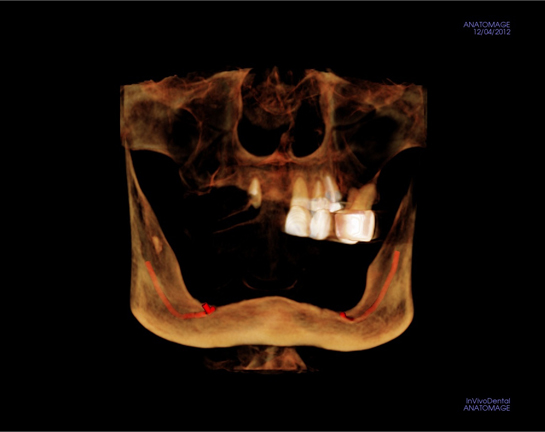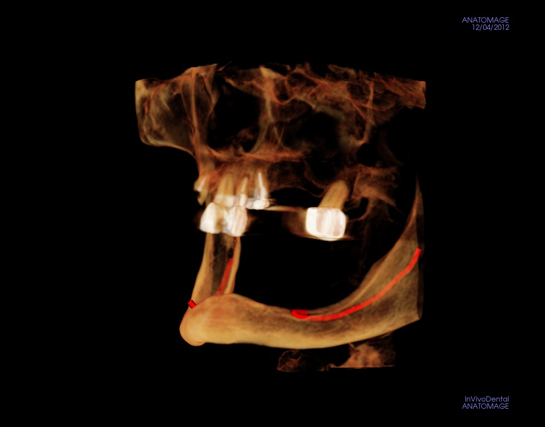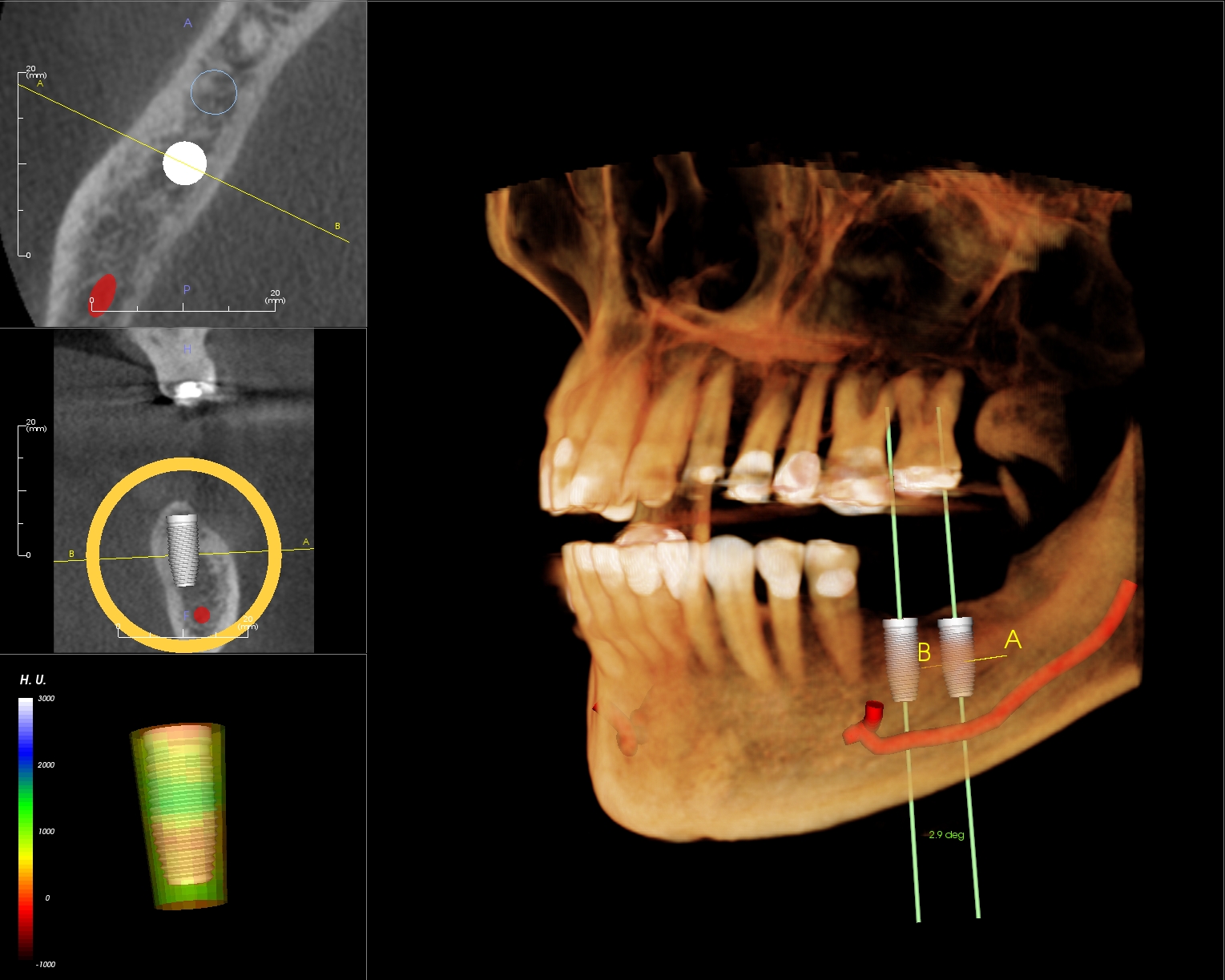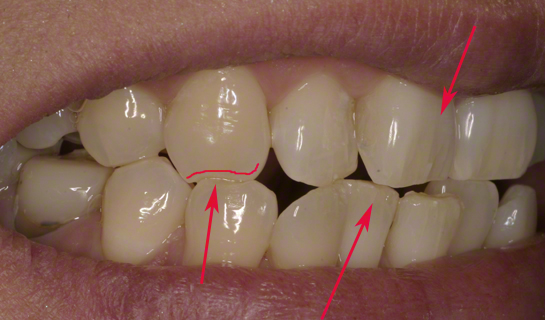What an interesting story covered by CNN today about Yelp reviews. http://www.cnn.com/video/data/2.0/video/bestoftv/2014/01/10/virginia-court-rules-on-yelp-reviewers-jackson-newday.cnn.html
Why Do Lower Dentures Hurt ?
I would like to dedicate this last dental blog entry of 2013 to patients who suffer pain from chewing with dentures. Most people think that the dentures put too much pressure on the gum, and so it hurts when they chew. However, when a patient has very little bone left in the jaw, the nerves which normally run deep inside the lower jaw is usually the the cause of the pain. In the image of my actual patient case below, you can see the two nerves ( in red on each side ) actually sit on the surface of the bone.
This is a severe case of bone loss leading to deficient arch form. When the denture pinches on these nerves, it is impossible to bite down without pain. The chewing efficiency is drastically reduced, and the quality of life is adversely affected for these patients.
It is important to understand the biology of bone as it relates to the chewing pressure. If the bone is not continually stimulated by a tooth root, then the bone will resorb in both height and width. Ideally, every tooth root that is lost should be replaced with an implant in order to preserve the volume of the bone around that root.
What then would be the solution to help denture patients who have inadequate bone, and whose residual nerves interfere with the denture bite force?
With proper comprehensive treatment planning using computerized 3D CT Scan, we can predetermine the exact location and size of the implants that can be placed in the bone. Once the implants are integrated with the bone, a prosthesis can be fixated on those implants to relieve all pressures from the underlying nerves and tissue. In a matter of months, we can completely reverse this patient's years of agonizing pain from trying to chew with a denture on a deficient ridge.
........................................................................................
Alex Nguyen, DDS is a Saratoga Dentist who practices General Dentistry, Cosmetic, and Implant Dentistry. For over 20 years the practice has been serving the residents of Santa Clara County and San Francisco Bay Area.
Is a CT Scan Necessary for Dental Implant Treatments?
In order to place an implant in the patient's jaw, we need to assess several criteria at the location of the planned implant. Some of the important factors may include: 1. The patient's bone height
2. The patient's bone width
3. The proximity to the nerves in the lower jaw
4. The proximity of the sinus cavity in the upper jaw
Using a 3D Cone Beam Scan (CT Scan) we can precisely analyze all of the above criteria and predetermine the exact size and location of the implant prior to the surgical placement.
Here is a screen capture of the planning process for two implants to replace two missing molars in our actual patient's lower jaw. The red line below the two planned implants is a nerve in the lower jaw. That nerve is often the limiting factor in the lower jaw where some implants for posterior teeth may be needed.
Proper use of technology helps ensure optimum results and safety of dental implant treatment.
........................................................................................
Alex Nguyen, DDS is a Saratoga Dentist who practices General Dentistry, Cosmetic, and Implant Dentistry. For over 20 years the practice has been serving the residents of Santa Clara County and San Francisco Bay Area.
How Much Do Dental Implants Cost?
I recently received this question via email. "My father wants to replace all upper teeth with implants. He will be paying cash. All the teeth have been removed about a year ago... Do you know around how much it would be? "
My answer to her was a bit lengthy, but basically:
There are many options for replacing teeth with implants.
1. You can have porcelain types of teeth that are fixed on the implants, or
2. Dentures that are retained by the implants. These two options determine how many implants should be placed. However, the patient's bone condition determine how many implants we could place. Therefore the cost depends on a number of things which may include: 1. Bone condition
2. The number of implants
3. The kind of prosthesis
Unless I have all the necessary records such as x-rays, CT scans, study models, and patient clinical exam, then it would be very difficult to estimate the cost.
It is important to understand that replacing one tooth with a dental implant is very different than replacing an entire arch with dental implants. Hence, you must seek a competent clinician to consult for a thorough understanding from the surgical aspects to the restorative choices. Cost is the final factor after you have arrived at a comprehensive treatment plan.
........................................................................................
Alex Nguyen, DDS is a Saratoga Dentist who practices General Dentistry, Cosmetic, and Implant Dentistry. For over 20 years the practice has been serving the residents of Santa Clara County and San Francisco Bay Area.
Why Should Adults Consider Orthodontic Treatments?
It is not uncommon that I recommend my patients to consider orthodontic treatments to straighten their teeth. Sometimes my adult patients' initial reaction would sound something like: "I am too old for that, and I never thought about the cosmetics of my smile..." Having straight teeth is not ALL about cosmetics.
The misalignment of teeth can cause a variety of problems ranging from TMJ issues, to bone loss, to excess fractures and wear facets on the teeth. This type of break down in the dentition can take many years to manifest. Unfortunately, sometimes when the patient starts to notice the problems, the solutions may require a complex combination of orthodontics and restorative treatments.
Properly aligned teeth actually follow very scientific principles created by nature to establish the most stable functional foundation. When teeth are properly aligned, certain functional movements of the jaw allow for optimum chewing, relaxed muscle state, and ideal joint health. The cosmetics of the smile is automatically achieved secondarily when the functional foundation is established. Finding the right orthodontist is key to successful treatment.
Hence, when you choose to have orthodontic treatment done, you are stabilizing the most important aspect of the dentition: To allow you to sustain life by being able to chew effectively throughout the course of your life span. As the human life span continues to lengthen, it is extremely important to make sure that you will continue to have a stable dentition for your chewing needs.
In the photos below you will find a smile with "crooked teeth". Whereas the patient was never concerned with the cosmetics of her smile before, she has lately been concerned with the fractures lines and wear facets indicated by the red arrows. Her question to me at the last check-up was: "What would my teeth look like...say ten years down the line..."
My answer to her was: "They would look more broken down, and you will also notice problems with the back teeth as well."
So as you can see... My recommendation for this patient to choose orthodontic treatment was based on achieving proper function, and not ALL about cosmetics.
-
-
........................................................................................
Alex Nguyen, DDS is a Saratoga Dentist who practices General Dentistry, Cosmetic, and Implant Dentistry. For over 20 years the practice has been serving the residents of Santa Clara County and San Francisco Bay Area.








